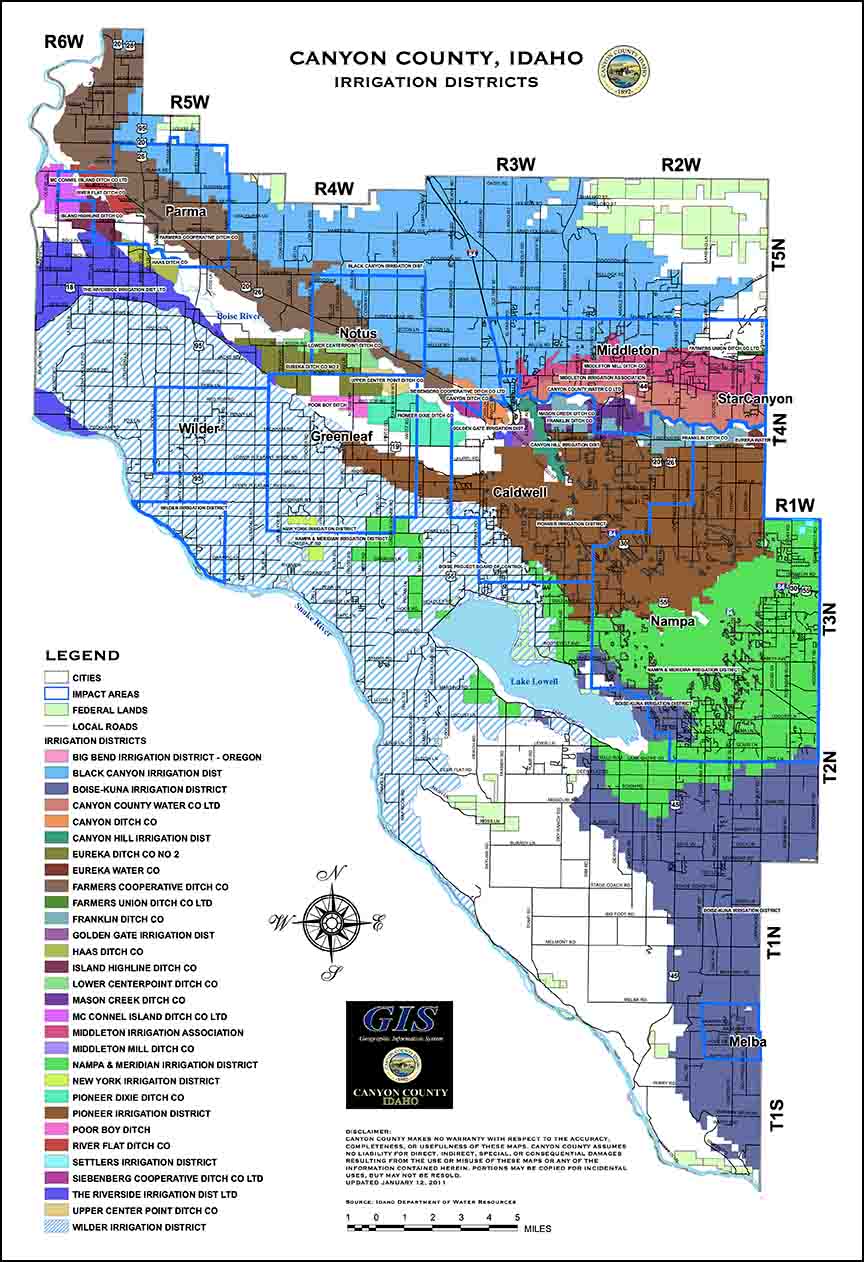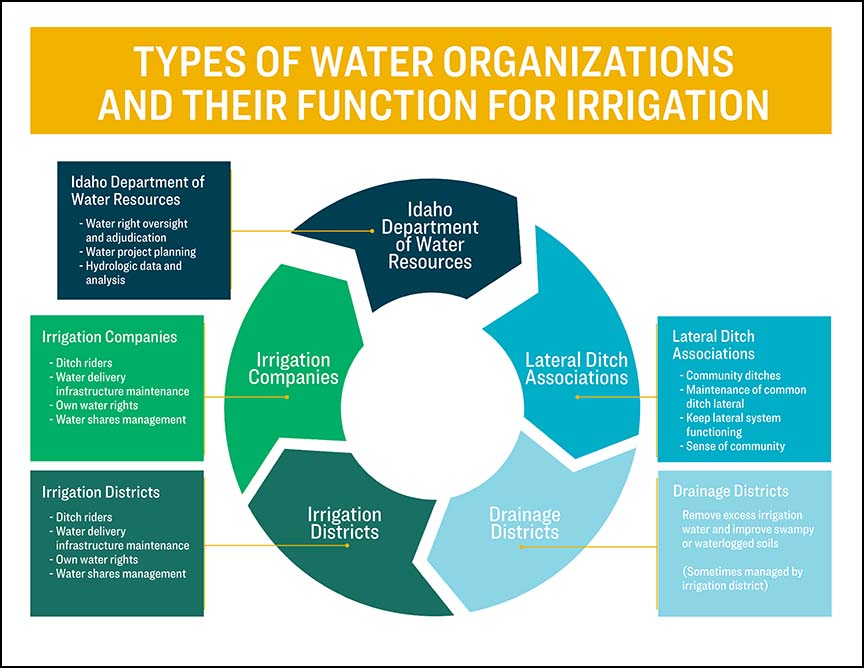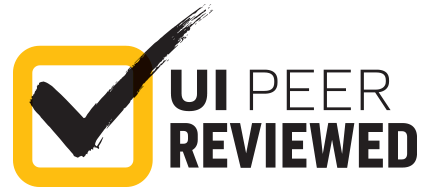Planning Water Access for Small-Acreage Irrigators
Introduction
Many of Idaho’s diverse landscapes and varying climates require seasonal irrigation for successful crop and livestock production. Small acreages, however, pose unique water-access problems, particularly when they are subdivisions of a larger-acreage property. Indeed, water shares and rights may not have carried over as part of the sale. As a result, the water supply and other related infrastructural services might be unreliable. Even having an irrigation ditch running next to your property, for instance, does not guarantee access to water. To help navigate these challenges, small-acreage landowners need to plan ahead. This guide helps small-acreage landowners to better understand water rights in Idaho and other issues related to setting up irrigation water access.
You may be considering purchasing property or already own land. In either case, accessing irrigation water in Idaho is not always a straightforward process. Thinking through it can be intimidating and overwhelming: Can I take water straight from the river? Does my new property come with access to water for irrigation? What are water rights and how are they different from water shares? What are irrigation districts? Can I use well water to irrigate my pasture? The answers vary, depending on your location and water use. But they all are based on the state’s legal system of water administration.
The set up for Idaho’s system, prior appropriation, is rooted in the gold-rush era, when miners diverted water from streams while searching for gold. Priority for water use was governed under the maxim, “first in time, first in right,” meaning that the first miner to put water to use in their operation had the first-priority right. After the first miner established their access right, a second miner could establish theirs, followed by subsequent water-right claims or holdings. Any unused water rights were considered abandoned and thus available to others. Miners established the system of prior appropriation during California’s gold rush of 1848; it migrated to Colorado in 1859, followed by Idaho by 1890 (Schorr 2021; Murphy 1935).
Prior appropriation remains the system Idaho relies on to administer water rights today. The Idaho State Water Board is the legal entity that regulates water use in conjunction with local irrigation organizations. For those interested in accessing water for both small-acreage agricultural production, as well as the maintenance of hobby farms and pastures, work with your local irrigation district or canal company. Either entity will help you to set up water delivery to your property.
Key Terms
acre foot (af). The volume of water necessary to cover one acre of surface area to a depth of one foot—325,851 gallons.
‘call’ on the river (water curtailment). To make a legal claim to the amount of river water to which you are entitled. A senior water-right holder can issue a suspension or reduction of water to junior water-rights owners. The action is often used in times of water shortage, drought, or other emergency.
cubic feet per second (cfs). A water-diversion rate that measures the quantity of water used for irrigation.
irrigation ditch or canal. An open waterway used to move diverted water from the source (i.e., a river) to a specified location for beneficial use, such as pasture irrigation.
ditch rider. A person employed by an irrigation district who manages water distribution to farms and other water users. Riders are like a water accountant who ensures that first-priority or senior water rights are met first and that ditch company members receive the requested amount of water. They also patrol an irrigation canal, inspecting turnouts and maintaining head gates and other irrigation equipment, among other water delivery–related responsibilities.
drainage district. An administrative entity created by landowners to coordinate the drainage management of a defined area (district). Helmed by a drainage commission, the drainage district legally levies property taxes to cover maintenance and construction costs.
irrigation companies or districts. Cooperative, self-governing, semipublic organizations (subdivisions of state or local governments) that have been set up to provide irrigation water. They manage water rights, diversion facilities, and infrastructure and distribute water to water shareholders. They are governed by a set of bylaws created by a board of directors who are elected by district members.
irrigation weir. A concrete structure built across an open irrigation channel that diverts water for irrigation; the height of the water above the weir helps users to measure the water volume.
lateral association and community and delivery ditch. Smaller ditch or pipeline system fed by an irrigation ditch or canal and delivered to one or more water users. Generally, neighbors with bylaws and rules of cooperation maintain the community ditch lateral in order to keep the lateral system functioning and to avoid conflicts. The collaboration that the system mechanics require often strengthen the sense of community among neighbors in rural areas.
prior appropriation. The legal doctrine governing water rights in the western United States. It mandates that the first person to take a quantity of water from a water source for "beneficial use" (agricultural, industrial, or household) has the right to continue to use that quantity of water for that purpose ("first in time, first in right”).
Water Rights
A water right authorizes water use in a prescribed manner. Prior appropriation provides the legal framework. The term originates from the water-right principle, "first in time, first in right.” However, water users do not own water. Instead, the state asserts sovereignty over the development and use of Idaho’s water resources for the benefit of its citizens. This contrasts with riparian rights, common in the water-rich eastern United States, that allow the diversion of water for irrigation if the stream or body of water penetrates a prospective user’s property. This system didn’t take hold in Idaho because of the state’s arid landscape—water must be transported longer distances to irrigate farmland. Instead, in Idaho each water right operates under legally defined elements that limit its use. These elements include priority date, purpose of use, quantity, point of diversion, place of use, season of use, and source (Table 1).
| Water Right Elements | Definition |
|---|---|
| Priority Date | The date when a person (or their predecessor) first began to use the water. Early water users are referred to as “senior,” while those who follow are called “junior.” A senior water-right holder is entitled to water before any junior right holders. This date also determines who gets access to the water’s use when there is a shortage. In a time of shortage, the water-right principle “first in time, first in right” holds sway. |
| Purpose of Use (Beneficial Use) | The particular beneficial water use under a water right: domestic, irrigation, stock watering, municipal, industrial, fish, and wildlife. |
| Quantity | Typically defined by diversion rate, period of use, and annual volume measured in cubic feet per second (cfs) and acre-feet (af). Water must be put to a continual beneficial use to maintain the allotted water quantity. |
| Point of Diversion | The location (stream, aquifer, lake, or other water source) where water is rerouted. Any change in the point of diversion requires approval of a transfer application. |
| Place of Use | A description of the area to be irrigated. |
| Season of Use | Identifies the time of the year when water is authorized to be diverted and used (i.e., irrigation season dates are set by the irrigation and canal companies). |
| Source | The body of water from which the water is to be appropriated or diverted. In the case of a surface right, the particular stream, spring, or lake is named. In the case of groundwater, the source is typically labeled groundwater. |
Water Shares
In many cases, an irrigation company or district holds the water rights and manages its allocation to members. Members purchase shares in the company for a specific amount of water, including its diversion from company-owned canals and ditches. The investments make each member a shareholder whose annual or semi-annual fees also cover the assessment costs for water maintenance, conveyance infrastructure, and administrative expenses.

The shares also represent a portion of the pool of water rights held by the irrigation organization. The seniority or “first in time, first in right” rule inherent in Idaho’s water-right system is usually not experienced by individual shareholders. Instead, the board sets “on” or “off” dates based on water availability. The total af of water granted to every paid, irrigatable acre is determined based on the amount of water storage for the season.
In southern Idaho, for example, the water year generally begins sometime in April and water is shut off around mid-October, though timing can vary. Water is turned on based on weather conditions and turned off based on storage levels. When the levels of reservoirs or rivers are low, water may be shut off earlier. In favorable water-level years, users may have more flexibility in accessing their water shares. During dry and low-water years, irrigation water remains locked and full rules apply, including 24-hour prior notice on calls for water. Turning off water can occur as early as mid-July during drier years. To check your reservoir levels, visit the Bureau of Reclamation’s Hydromet website: https://www.usbr.gov/pn/hydromet/select.html.

Irrigation Organizations and Water Delivery
Irrigation organizations are the backbone of water access and allocation in Idaho (see the sidebar, Key Terms, for definitions). Irrigation companies, districts, and canal company rules, regulations, and water availability vary greatly across the state and even within the same county. Work with your irrigation organization and neighbors to understand the irrigation rules and practices in your area. Some counties supply irrigation boundary maps (see Figure 1). Each color represents a different irrigation organization. Organizations can deliver water within their boundaries only. For a visual of the types of water organizations, please see Figure 2.
In general, your irrigation organization diverts water from a river or stream and delivers it to your lateral ditches at the headgate. Most are responsible for the development and maintenance of canals and ditches. Most of these groups do not control the water flow or infrastructure that operates past your delivery point, or weir. Indeed, ditch riders focus on getting the water where it needs to go based on users’ water orders. For example, when you call in a water order to an irrigation company or district, the ditch rider adjusts the gate, opening and closing the headgate. Akin to a water accountant, the ditch rider keeps track of a client’s water usage by measuring the overall volume of water and by maintaining water-order records. Riders also do other kinds of maintenance, including keeping the ditches clean and flowing, managing conflict, and responding to irrigators’ questions.
Lateral associations and community and delivery ditches (see definitions in Key Terms) usually superintend the maintenance of the lateral ditch system. In areas that haven’t yet established formal associations, local irrigators themselves must develop their own maintenance strategy to ensure timely water delivery.
Groundwater from Your Well
Since groundwater rights are held by the property owner and surface water conveyance systems use is not required, well water use does not necessitate arrangements with irrigation organizations. However, all groundwater in the state is state property, like the previously discussed surface waters. The use of groundwater may thus be acquired only by appropriation through the Idaho Department of Water Resources (IDWR) water-right approval process. After approval, the IDWR issues a drilling permit for an irrigation well. Application review typically takes three to four months. One category of wells, called “domestic wells,” does not require appropriation but does require a well construction permit. Domestic wells allow for irrigation of up to a half acre of land with a total use that does not exceed 13,000 gallons per day.
Conclusion
Whether you’re irrigating from a well, an irrigation ditch, or own water shares or water rights, water access is administered by the IDWR under the system of prior appropriation. The local irrigation district or company is a key resource for landowners with deeded water shares or water rights. If you don’t have either shares or rights, they can inform you of your water access options. Importantly, each irrigation organization operates differently based on local climate and land-use patterns, water-user needs, and elected boards. Visit with the IDWR and local irrigation organizations before purchasing a property so you are informed on the amount, timing, and season of water access and to ensure that it meets your small-acreage goals.
Resources
Find your well diggers’ report: https://idwr.idaho.gov/wells/find-a-well-map/
Irrigation Rights Finder map: https://maps.idwr.idaho.gov/agol/IrrigationRights/
Ground Water and the Rural Homeowner: https://pubs.usgs.gov/gip/gw_ruralhomeowner/
Find your regional Idaho Department of Water Resources Office: https://idwr.idaho.gov/contact-us/
Find your irrigation organization: https://maps.idwr.idaho.gov/agol/IrrigationOrganizations/
Keep tabs on your reservoir levels: https://www.usbr.gov/pn/hydromet/select.html
Establishing a new water right (Water Rights Brochure): https://idwr.idaho.gov/wp-content/uploads/sites/2/water-rights/water-rights-brochure.pdf
Information on domestic wells (Exempt Wells in Idaho): https://na.eventscloud.com/file_uploads/c63eed855c83084cd29f5ed5d421bdca_Neace.pdf
References
Murphy, P. 1935. Early Irrigation in the Boise Valley. Pacific Northwest Quarterly 44(4):177-84
Schorr, D. 2012. The Colorado Doctrine: Water Rights, Corporations, and Distributive Justice on the American Frontier. New Haven, CT: Yale University Press.
About the Authors
Karie Boone (PhD)—Extension Educator, Payette County
Jennifer Werlin—Extension Educator, Teton County
BUL 1002 | Published September 2021 | © 2022 by the University of Idaho











